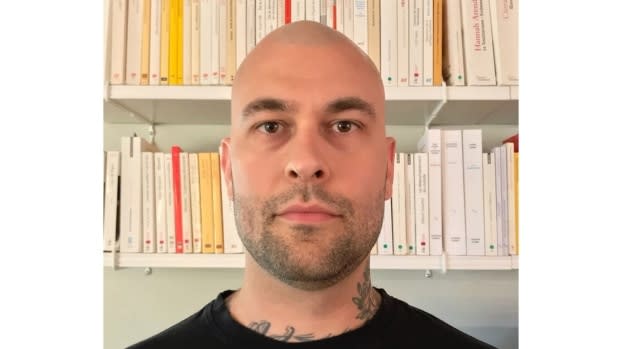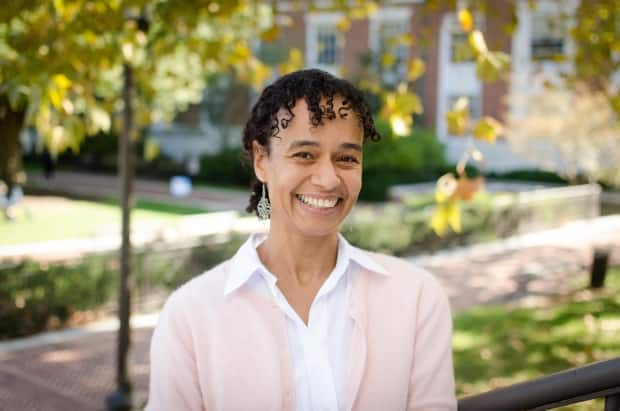How the myth of the Montreal street gang led to more street checks on Black youths
The two boys are cooling off after hours of volunteer gardening for seniors on a sweltering June afternoon.
Quiet and unassuming, they're leaning against the side of the Maison des jeunes de Rivière-des-Prairies, where they've been hanging out and participating in the Montreal youth centre's activities for the past couple of years.
The centre's director, Constane Vincent, says Black youths like them are regularly targeted by police in the neighbourhood, so she has asked the two teenagers to stay on and talk with a reporter about their experiences.
The boys are only 13 and 16, and they already know to be afraid of the police.
"If you've never experienced racism, you can't really understand it," said the youngest. Neither wanted to be named because they fear bullying for speaking out.
The protests against anti-Black racism across North America and the events that led to them have shaken the boys, but the story is not new to their community.
Though anti-Black racism in Quebec can be traced back generations, advocates and researchers say a turning point in Montreal history changed the way police in the city interact with young Black people.
A series of newspaper articles in the late 1980s introduced the concept of street gangs in Montreal, and the myth has been hard to dispel since, they say.
"Adolescents terrorize the city's north end," read one headline. "The threatening shadow of posses hangs over Montreal," said another.
Police at the time said gangs didn't yet exist in the city and didn't pose a real threat to public security.
Still, the news stories had a lasting impact, the researchers say, encouraging a style of policing that targets young Black people and other people of colour under the guise of crime prevention.

Vincent and others say that until the SPVM (Service de police de la Ville de Montréal) recognizes the practices that lead its officers to disproportionately stop people of colour, it will not be able to eradicate racism within its ranks.
On Wednesday, the SPVM announced its revamped street checks policy, after a report released last fall found its officers stopped Black people four to five times more than white people. Under the new policy, officers must now base their stops on observable facts and not "discriminatory motives."
The new policy is already being widely criticized. Vincent calls it vague and confusing.
"They need to say what kind of observable facts they're talking about," she said.
Justifying police spending
Benoit Décary-Secours, a researcher at the Centre de recherche sur les inégalités sociales à Montréal (CREMIS), which operates under one of the city's health boards, published some of his findings about the 1980s Quebec newspaper coverage on gangs in the latest edition of the journal published by the centre.
"What we've noticed is that for the past 30 years in Quebec, the 'street gang' has been used as a type of scapegoat to justify police spending and intensive and aggressive policing of minorities living in poor urban areas," said Décary-Secours, a postdoctoral fellow in sociology at Université de Montréal.
He found that the concept arose at a time when Black communities in the city were denouncing the racism they faced in Quebec society and that it was not linked to any clear phenomenon of crime.
The articles Décary-Secours examined, mostly published in the Journal de Montréal and La Presse, presented street gangs as a threat, tying them to groups of immigrants from Haiti and Jamaica and pointing to gang violence in the United States.

Décary-Secours wrote that the media coverage "mobilized the collective fear of the 'other,'" laying the foundation for the covert racism tied into the concept of street gangs.
The police discourse soon evolved from denying the phenomenon existed to saying police would focus on gang prevention to reassure the public.
By the early 2000s, all levels of government were investing millions into gang prevention programs in police and social work. Nearly every Montreal police budget between 2004 and 2017 (the latest the SPVM has published) mentions "the fight against street gangs" as a priority.
In 2007, the SPVM boasted of spending nearly 95,000 hours — the equivalent of about 4,000 days — patrolling "areas linked to street gangs." That year, it created Éclipse, a squad of 66 police officers focused on the fight against street gangs, funded by $92 million from the federal government and $34 million from the provincial government.
In its 2012-2014 plan on racial profiling, the SPVM admitted some practices by the squad "could be perceived as discriminatory."
When there's a group of Black kids around the high school nearby, they're called a street gang. But when the white kids get together, they're just 'having fun.' - Constane Vincent, director of the Maison des jeunes de Rivière-des-Prairies
Anne-Marie Livingstone, a postdoctoral fellow with Harvard University's Canada Program at the Weatherhead Center for International Affairs, conducted a study into the racial profiling of youth in Montreal's Saint-Michel neighbourhood in 2018.
Interviews with dozens of young people who'd been stopped by police revealed they were repeatedly targeted for minor offences, like biking on the sidewalk, spitting or throwing a cigarette on the ground. Police patrols would often silently circle parks where kids played.
"That kind of nonverbal intimidation, you can imagine, makes kids feel unsafe," said Livingstone.

Livingstone's research revealed teenagers in Saint-Michel were no more delinquent than in any other part of the city. But she says that surveillance has instilled fear in young people of colour, affecting the ways they move through their neighbourhoods and which services they seek out.
She found the fear of gangs did not only justify "more intensive policing, but also affected the quality of the social services" offered to Black youth. The teens worried they would be seen as members of street gangs, not only by police but by organizations serving their communities.
At the Rivière-des-Prairies youth centre, Vincent has seen evidence of that. She said teens requested discussions about racism, how to deal with it, and what to do during police interactions.
"When there's a group of Black kids around the high school nearby, they're called a street gang. But when the white kids get together, they're just 'having fun,'" Vincent said.

SPVM's bank of 10,000 names
In a statement to CBC News, the SPVM said it "no longer favours the use of the term 'street gang,'" and its operations aimed at curbing the kind of illegal activities previously attributed to such gangs now have the broader aim of "combatting violent crime."
"Like the society around it, the SPVM is constantly evolving and adapting its way of doing things," the statement said, pointing to the new street checks policy as an example.
It says that policy came about as a result of collaborating with "many ethnocultural communities, health-care organizations and street workers."
After police shot and killed 18-year-old Fredy Villanueva in 2008, the SPVM hired criminologist Mathieu Charest to compile data on police actions in the Montréal-Nord neighbourhood where the teen grew up.
Charest found that 30 to 40 per cent of young Black men in Montréal-Nord and Saint-Michel had had their identity checked by police, compared to five to six per cent for their white peers.
The SPVM rejected his findings, saying there were flaws in the methodology.
The criminologist also discovered the SPVM kept a bank of 10,000 names it believed could be linked to street gangs, despite the fact the police service estimated only about 500 Montrealers were gang members.
When the SPVM's anti-gang efforts ramped up between 2001 and 2007, Charest found street checks on Black people increased by 126 per cent in Montréal-Nord and 91 per cent in Saint-Michel.
A self-fulfilling prophecy
Décary-Secours, the CREMIS sociologist, said the mythology of street gangs in Montreal became something of a self-fulfilling prophecy.
So-called gangs were eventually formed, but they don't represent the kind of widespread threat law enforcement agencies in the province made them out to be, he said.

"The label is most often imposed on them," Décary-Secours said. "Then afterwards there's some sociological process where youth become conscious of these labels we impose on them, and they reclaim it."
He says the young people he interviewed for his research often laughed at the characterization.
Many of the groups in Canada and the United States arose as a result of racism faced by young people.
"They felt the need to form peer groups based on their common experience of exclusion," Décary-Secours said.
"When we see that these labels that justify intensive policing are not really clear to anyone in the field — from the youth, to the police, to the social workers — I think it is a way to question what is the function of the police in our society."
The sight of a police officer instantly instills fear, the two Black teens at the Rivière-des-Prairies youth centre say.
They know it shouldn't be that way. They know their white friends don't have the same reaction.
"Police are supposed to protect us," the 13-year-old said. "Not hurt us."


